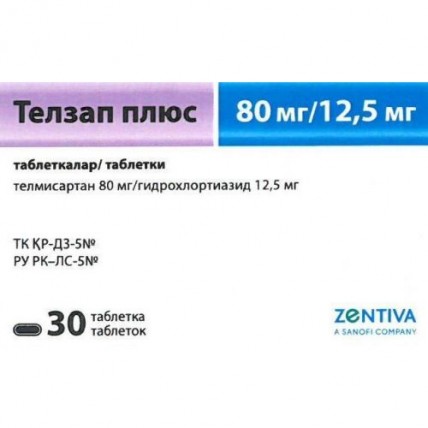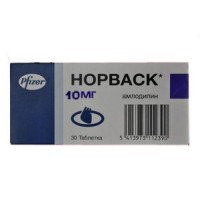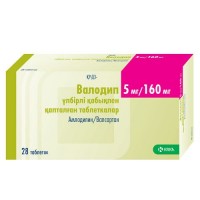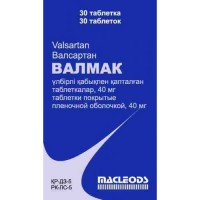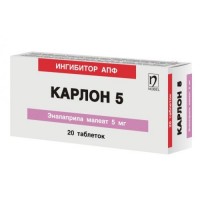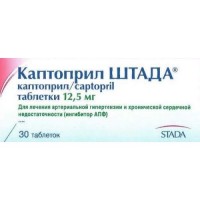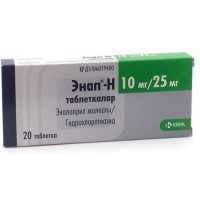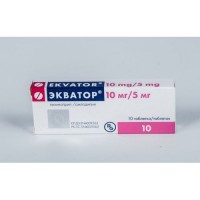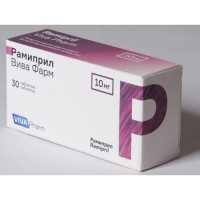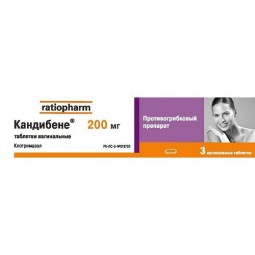Telzap Plus 80 mg / 12.5 mg (30 tablets)
- $16.10
Out Of Stock
The instruction for medical use of medicine of Telzap Plus Torgovoye nazvaniye Telzap Plus the International unlicensed name Is not present the Dosage form of the Tablet of 40 mg / 12.5 mg, 80 mg / 12.5 mg, 80 mg / 25 mg Structure One tablet contains active agents: telmisartan 40.000 or 80.000 mg respectively, Hydrochlorthiazidum of 12.500 mg or 25.000 mg respectively, excipients: sorbitol, sodium hydroxide, povidone 25, magnesium stearate the Description of the Tablet of oblong shape with a biconvex surface from white till yellowish color, with the squeezed-out figure 41 on one party of a tablet, about 12 mm long, about 6 mm wide (for a dosage of 40 mg / 12.5 mg). Tablets of oblong shape with a biconvex surface from white till yellowish color, with the squeezed-out figure 81 on one party of a tablet, about 16.5 mm long, about 8.3 mm wide (for a dosage of 80 mg / 12.5 mg). Tablets of oblong shape with a biconvex surface from white till yellowish color, with the squeezed-out figure 82 on one party of a tablet, about 16 mm long, about 8 mm wide (for a dosage of 80 mg / 25 mg). Pharmacotherapeutic group the Drugs influencing a system renin-angiotensin, antagonists of angiotensin II with diuretics. Telmisartan and diuretics the ATX C09DA07 Code the Pharmacological Pharmacokinetics Simultaneous Use properties of a hydrochlorothiazide and telmisartan does not influence pharmacokinetics of these drugs. Absorption Telmisartan: After oral administration the peak concentration of a telmisartan are reached in 0.5 - 1.5 h. The absolute bioavailability of a telmisartan in a dose of 40 mg and 160 mg is 42% and 58%, respectively. At reception of a telmisartan along with food the decrease in AUC (the area under a curve concentration time) fluctuates from 6% (at a dose of 40 mg) up to 19% (at a dose of 160 mg). 3 hours later after reception the concentration in blood plasma is leveled, irrespective of meal. Small decrease in AUC does not cause decrease in therapeutic effectiveness. The pharmacokinetics of an oral telmisartan is nonlinear at doses of 20 - 160 mg with more than proportional increase in concentration in plasma (Smaks and AUC) with increase in a dose. Clinically significant cumulation of a telmisartan is not found. Hydrochlorthiazidum: after oral administration of Telzap Plus the peak concentration of Hydrochlorthiazidum are reached approximately in 1.0 - 3.0 h after administration of drug. On the basis of cumulative renal excretion of Hydrochlorthiazidum the absolute bioavailability is about 60%. Distribution Telmisartan substantially contacts proteins of plasma (more than 99.5%), generally albumine and an alpha 1-acid glycoprotein. The volume of distribution is about 500 l that indicates additional fabric binding. Hydrochlorthiazidum for 68% contacts proteins of plasma and the volume of distribution is 0.83 - 1.14 l/kg. Biotransformation Telmisartan is metabolized by conjugation with formation pharmacological of an inactive acylglucuronide. The glucuronide of initial connection is the only metabolite which was identified at the person. After a single dose of a 14C-mechenny telmisartan the glucuronide makes about 11% of the measured radioactivity in plasma. P450 cytochrome and isoenzymes do not participate in metabolism of a telmisartan. Hydrochlorthiazidum is not metabolized at the person Vyvedeniye Telmisartan: After intravenous or oral administration of a 14C-mechenny telmisartan the majority of the entered dose (& gt, 97%) is removed with a stake through bilious excretion. Small volumes were found in urine. The general plasma clearance of a telmisartan after oral administration is also gt, 1500 ml/min. Terminal elimination half-life составляет>, 20 hours. Hydrochlorthiazidum is removed almost completely in not changed view with urine. About 60% of an oral dose are removed within 48 hours. The renal clearance is about 250 - 300 ml/min. Terminal elimination half-life makes 10 - 15 hours. Special populations Patients of advanced age the Pharmacokinetics of a telmisartan does not differ at elderly people and patients 65 years are younger. A floor Plasma concentration of a telmisartan is 2 - 3 times higher at women, than at men. In clinical trials the reliable increase in the answer of arterial blood pressure or frequency of orthostatic hypotension at women was not observed. Correction of a dose is not required. The tendency to higher concentrations in Hydrochlorthiazidum plasma at women, than at men was observed. It has no clinical importance. Patients with a renal failure the Renal excretion does not affect clearance of a telmisartan. By results of insignificant experience of use of Telzap Plus for patients with a slight and moderate renal failure (clearance of creatinine of 30 - 60 ml/min., average value about 50 ml/min.), correction of a dose is not necessary at patients with the lowered function of kidneys. Telmisartan is not brought from blood by a hemodialysis. At patients with renal failures the clearance rate of Hydrochlorthiazidum decreases. In a research at patients with average clearance of creatinine of 90 ml/min. the elimination half-life of Hydrochlorthiazidum was increased. At patients with a nonfunctional kidney the elimination half-life makes about 34 hours. Patients with a liver failure At patients with a liver failure the absolute bioavailability of a telmisartan increases to 100%. Elimination half-life in a liver failure does not change. The pharmacodynamics of Telzap Plus represents a combination of the antagonist of a receptor of angiotensin II (APAII), a telmisartan, and thiazide diuretic, Hydrochlorthiazidum. The combination of these components has the additive antihypertensive effect reducing arterial blood pressure more than each component independently. Telzap Plus at reception of times a day leads to an effective and smooth lowering of arterial pressure. Telmisartan is an effective and specific (selection) antagonist of receptors of angiotensin II (AT1 type) for intake. Telmisartan with very high similarity forces out angiotensin of II of places of its binding in receptors of subtype 1 (AT1) which are responsible for the known effect of angiotensin II. Telmisartan does not show any partial activity of agonist concerning receptor AT1. Telmisartan selectively contacts AT1 a receptor. Binding is long-term. Telmisartan does not show affinity to other receptors, including to AT2 to a receptor and another, less studied by AT receptors. The functional value of these receptors and also effect of their possible excess stimulation by angiotensin II which concentration increases when assigning a telmisartan, are not studied. Telmisartan reduces Aldosteronum level in plasma, does not block renin in plasma of the person and ion channels. Telmisartan does not inhibit angiotensin-converting enzyme (kinase of II) which reduces production of bradykinin. Therefore there is no strengthening of the side effects connected with effect of bradykinin. 80 mg the dose of a telmisartan entered to healthy volunteers almost completely inhibits increase pressure caused by influence angiotensin II. The braking effect remains more than 24 hours (till 48 o'clock). After reception of the first dose of a telmisartan of the ABP decreases in 3 hours. The maximum lowering of arterial pressure, as a rule, is reached in 4-8 weeks after an initiation of treatment and remains during long-term therapy. Hypotensive action continues within 24 hours after administration of drug, including 4 hours before reception of the next dose that is confirmed by measurements of the ABP and also out-patient steady (it is higher than 80%) ratios of the minimum and maximum concentration of drug after reception of 40 and 80 mg of a telmisartan in placebo - controlled clinical trials. At patients with hypertensia telmisartan reduces both systolic, and diastolic arterial blood pressure, without mentioning heart rate. The antihypertensive efficiency of a telmisartan is comparable with representatives of other classes of hypotensive drugs (as shown in the clinical trials comparing telmisartan with amlodipiny, atenolol, enalapril, Hydrochlorthiazidum and lisinopril). In double blind controlled clinical trial (N = 687 patients who were estimated regarding efficiency) at the persons who are not answering a combination of 80 mg / 12.5 to mg showed gradual effect of a lowering of arterial pressure of a combination of 80 mg / 25 to mg in comparison with long-term treatment by a dose of 80 mg / 12.5 in mg of 2.7/1.6 mm Hg. (GARDEN/DAD) (a difference in the corrected average changes of relative initial level). In a research with a combination of 80 mg / 25 mg arterial blood pressure decreased that led 11.5/9.9 mm Hg to the general decrease. (GARDEN/DAD). In the generalized analysis of two similar 8 weeks double blind placebos - controlled clinical trials in comparison valsartana / Hydrochlorthiazidum of 160 mg / 25 the mg (N = 2121 patients who were estimated regarding efficiency) was observed bigger effect of a lowering of arterial pressure of 2.2/1.2 mm Hg. (GARDEN/DAD) (a difference in the corrected average changes from initial level, respectively) in favor of a combination telmisartan / Hydrochlorthiazidum of 80 mg / 25 mg. After the sharp termination of treatment telmisartany arterial blood pressure gradually returns to initial value within several days without symptoms of a ricochet hypertension. In the clinical trials which are directly comparing two types of treatment, the frequency of dry cough was much lower at the patients receiving telmisartan than at receiving angiotensin-converting enzyme inhibitors In the research Mode of Prevention of Effective Prevention of Repeated Strokes (PRoFESS) conducted at patients 50 years which had a stroke recently are more senior, increase in cases of sepsis at use of a telmisartan in comparison with placebo, 0.70% in comparison with 0.49% was observed
, the frequency of fatal cases from sepsis was higher at the patients accepting telmisartan (0.33%) in comparison with patients who accepted placebo (0.16%)
. The observed increase in frequency of developing of sepsis connected with use of a telmisartan can be or the accidental phenomenon or can be connected with the mechanism which is not known now. Effects of a telmisartan on mortality and cardiovascular incidence are unknown now. Hydrochlorthiazidum is thiazide diuretic. The mechanism of antihypertensive effect of thiazide diuretics is completely not known. Tiazida influence renal mechanisms of a reabsorption of electrolytes in tubules, directly increasing excretion of sodium and chloride in approximately equivalent sizes. Diuretic effect of Hydrochlorthiazidum reduces plasma volume, increases activity of renin of plasma, increases secretion of Aldosteronum with the subsequent increase in potassium in urine, loss of bicarbonate and reduction of serumal potassium. Presumably through blockade system renin-angiotensin-aldosteronovoy joint purpose of a telmisartan, as a rule, interferes the loss of potassium connected with these diuretics. At Hydrochlorthiazidum use the beginning of a diuresis occurs in 2 hours, and the peak effect arises approximately in 4 hours while action remains within about 6-12 hours. Epidemiological researches showed that long-term treatment by Hydrochlorthiazidum reduces risk of cardiovascular mortality and incidence. Indications - treatment of essential arterial hypertension (in case of inefficiency of a telmisartan or a hydrochlorothiazide in the form of monotherapy) the Route of administration and doses of Vzroslye Tabletki Telzap Plus are intended for oral administration regardless of meal, are accepted once a day and have to be washed down with water. Telzap Plus is appointed to patients at whom arterial blood pressure is not controlled adequately at monotherapy telmisartany. Individual titration of a dose of each of two components is recommended before transition to a combination of the fixed dose. At clinical compliance, direct transition from monotherapy to the fixed combination can be considered. Telzap Plus of 40 mg / 12.5 mg can be accepted once a day to patients whose arterial blood pressure is not controlled adequately monotherapy of telmisartany 40 mg. Telzap Plus of 80 mg / 12.5 mg can be accepted once a day to patients whose arterial blood pressure is not controlled adequately monotherapy of telmisartany 80 mg. Telzap Plus of 80 mg / 25 mg can be accepted once a day to patients whose arterial blood pressure is not controlled adequately at use of a dose of Telzap Plus of 80/12.5 mg or for patients which arterial blood pressure was stabilized on the telmisartena and Hydrochlorthiazidum separately earlier. Use for elderly people Correction of a dose is not required. Patients with a renal failure the periodic control of function of kidneys Is recommended (see the section Special Instructions) Patients with a liver failure At patients with a slight and moderate liver failure the dosage should not exceed Telzap Plus of 40 mg / 12.5 mg once a day. Telzap Plus is not shown to patients with heavy abnormal liver functions. Tiazida it is necessary to use with care at patients with abnormal liver functions (see the section Special Instructions). Children Safety and efficiency of use of Telzap Plus for children and teenagers aged up to 18 years is not established. Data are not available. Side effects the General frequency of emergence of the undesirable phenomena at reception of Telzap Plus is comparable with that at monotherapy telmisartany during a number of researches with the assistance of 1471 patients receiving a combination of a telmisartan and Hydrochlorthiazidum (835) or only telmisartan (636). The undesirable phenomena did not depend on a dose, are not connected with sex, age or race of the patient. The undesirable phenomena observed during clinical trials of a combination of a telmisartan and Hydrochlorthiazidum are given below with use of the following classification: Very often (≥ 1/10), it is frequent (≥ 1/100 to & lt, 1/10), infrequently (≥ 1/1000 to ≤ 1/100), is rare (≥ 1/10,000 to ≤ 1/1000), is very rare (≤ 1/10,000), it is not known (assessment on the basis of the available data is impossible). Often - dizziness Infrequently - a hypopotassemia - feeling of concern, alarm - a faint, paresthesias - dizziness (disturbance from an organ of hearing and a vestibular mechanism) - tachycardia, arrhythmia - hypotonia, orthostatic hypotension - short wind - diarrhea, a meteorism, dryness in a mouth - a dorsodynia, muscular spasms, myalgia - erectile dysfunction - a stethalgia - increase in level of uric acid in blood Is rare - a Quincke's edema (death), an erythema, an itching, rash, perspiration, urticaria - bronchitis, pharyngitis, sinusitis - aggravation or activation of a system lupus erythematosus (on the basis of post-marketing experience) - a hyperuricemia, a hyponatremia - a depression - insomnia, a sleep disorder - a disorder of vision, indistinct sight - respiratory nedostatochnocht (including pneumonia and a fluid lungs) - an abdominal pain, a constipation, dyspepsia, vomiting, gastritis - an arthralgia, muscular spasms, extremity pains - abnormal disorders of function of a liver (see the section Description of Separate Side Reactions is possible) - a grippopodobny state - increase in level of creatinine, a kreatinfosfokinaza, liver enzymes Additional information on separate components the Side reactions which are earlier reported on separate components of the combined drug can be potential side reactions at use of Telzap Plus even if they are not observed in clinical trials of this combined drug. Telmisartan: Side reactions arose with an identical frequency at patients who received placebo and telmisartan. In placebo - controlled researches the general frequency of side reactions at use of a telmisartan (41.4%), as a rule, is comparable to placebo (43.9%). The following side reactions which are listed below were received from all clinical trials at the patients receiving telmisartan concerning a hypertension or at patients 50 years with high risk of cardiovascular events are more senior. Infrequently - upper respiratory tract infections, infections of urinary tract, including cystitis - anemia - a hyperpotassemia - bradycardia - cough - a renal failure (including sharp pochech
aya insufficiency) - an asthenia Seldom - sepsis including from the death (see the section Description of Separate Side Reactions) - an eosinophilia, thrombocytopenia - hypersensitivity, anaphylactic reactions - a hypoglycemia (at patients with diabetes) - drowsiness - discomfort in a stomach - eczema, medicamentous medicinal rash, toxic rash - arthrosis, sinew pain - decrease in level of hemoglobin is Very rare - an interstitial disease of lungs (see the section Description of Separate Side Reactions) Hydrochlorthiazidum: can cause or aggravate a hypovolemia that can lead to an electrolytic imbalance (see the section Special Instructions) Frequency is not known - a sialadenitis - aplastic anemia, hemolytic anemia, insufficiency of marrow, a leukopenia, a neutropenia, an agranulocytosis, thrombocytopenia - anaphylactic reactions, hypersensitivity - nekonroliruyemy diabetes - anorexia, a loss of appetite, an electrolytic imbalance, a hypercholesterolemia, a hyperglycemia, a hypovolemia - concern, dizziness - nonsense - a xanthopsia, acute closed-angle glaucoma - a necrotic vasculitis - pancreatitis, discomfort in a stomach - jaundice hepatocellular, jaundice cholestatic - a lupoid and similar syndrome, a photosensitization, a skin vasculitis, a toxic epidermal necrolysis - weakness - interstitial nephrite, renal dysfunction, a glucosuria - a hyperthermia - increase in level of triglycerides the Description of separate side reactions Dysfunction liver liver/disorder In most cases dysfunction liver liver/disorder from post-marketing experience with telmisartany arose at patients from Japan. Residents of Japan, with the largest probability have these side reactions. Sepsis In the research PRoFESS, increase in frequency of cases of sepsis was observed in group of treatment telmisartany in comparison with placebo. The phenomenon can be accidental or connected with the mechanism which is not known now (see the section Pharmacodynamics). Interstitial diseases of lungs Cases of interstitial damage of lungs were registered during the post-marketing researches with use of a telmisartan. Nevertheless, relationship of cause and effect was not established. The reporting on the suspected side reactions the Reporting on expected side reactions allows to continue monitoring of a ratio advantage/risk of medicine. Health workers have to report about any expected side reactions. Contraindications - hypersensitivity to active agents or to any of excipients - hypersensitivity to other sulfonamidsoderzhashchy substances (as Hydrochlorthiazidum is sulfonamidsoderzhashchy medicine) - II and III trimesters of pregnancy and the period of a lactation - a cholestasia and obstructive diseases of biliary tract - an abnormal liver function - a heavy renal failure (clearance of creatinine & lt, 30 ml/min.) - a stable hypopotassemia, a hypercalcemia - joint reception with aliskireny at patients with diabetes or a renal failure (SKF & lt, 60 ml/min. / 1.73 sq.m) - hereditary intolerance of fructose, galactoses (galactosemia) - children's and teenage age up to 18 years Medicinal interactions of Lities Reversible increase in concentration of lithium in blood serum and toxicity was registered during the accompanying prescribing of lithium with angiotensin-converting enzyme inhibitors. Also exceptional cases at use of antagonists of receptors of angiotensin II were reported (including Telzap Plus). Simultaneous use of lithium and Telzap Plus is not recommended (see the section Special Instructions). If this combination is necessary, it is recommended to carry out careful monitoring of level of serumal lithium to treatment time. The medicines causing loss of potassium and a hypopotassemia (for example, others potassiumuretic diuretic, laxative, corticosteroids, AKTG, Amphotericinum, karbenoksolon, sodium penicillin G, salicylic acid and its derivatives) When prescribing these drugs with a combination Hydrochlorthiazidum-telmisartan, monitoring of level of potassium in blood is recommended. These medicines can strengthen influence of Hydrochlorthiazidum on potassium level in blood serum (see the section Special Instructions). The medicines increasing potassium level in blood and causing a hyperpotassemia (for example, the APF inhibitors, kalisberigayushchy diuretics, additives of potassium, salts containing potassium, cyclosporine or other medicines, such as heparin sodium). If these medicines are appointed along with a combination Hydrochlorthiazidum-telmisartan, monitoring of level of potassium in blood is recommended. As a matter of experience can lead uses of other medicines inhibiting a system renin-angiotensin, simultaneous use of the above-stated medicines to increase in level of potassium in serum and, therefore, it is not recommended for use (see the section Special Instructions). The medicines reacting to changes of level of potassium in serum Periodic control of level of potassium in blood serum and the ECG it is recommended at appointment of Telzap Plus with the medicines reacting to changes of content of potassium in blood serum (for example, cardiac glycosides, antiarrhytmic means) and also with the medicines inducing trembling and ventricular fibrillation (for example some antiarrhytmic means), at the same time the hypopotassemia is the contributing factor to trembling and ventricular fibrillation. - antiarrhytmic drugs of the class Ia (for example, quinidine, hydroquinidine, Disopyramidum) - antiarrhytmic drugs of class III (for example, Amiodaronum, sotalol, dofetilid, ibutilid) - some antipsychotic drugs (for example, thioridazine, Chlorpromazinum, levomepromazinum, trifluoperazin, tsiamemazin, Sulpiridum, sultoprid, amisulprid, tiaprid, Pimozidum, a haloperidol, Droperidolum) - other drugs (for example, bepridit, tsisapridy, difemanit, erythromycin IV, galofantrin, mizolastin, pentamidine, sparfloksatsin, terfenadin, Vincaminum IV) Cardiac glycosides the Hypopotassemia or a hypomagnesiemia induced by tiazida promote the arrhythmia induced by cardiac glycosides (see the section Special Instructions). Hypotensive effect of other hypertensive drugs can increase other Telmisartan antihypertensive drugs. Antidiabetic medicines (oral drugs and insulin) regulation of a dosage of antidiabetic medicines Can be required (see the section Special Instructions). Metformin Metformin should be used with care. Risk of the lactoacidosis induced by the possible functional renal failure connected with Hydrochlorthiazidum. Holestiramin and kolestipolovy pitches Absorption of Hydrochlorthiazidum is broken in the presence of anion exchange pitches. NPVS non-steroidal anti-inflammatory drugs (i.e. acetylsalicylic acid at use in anti-inflammatory schemes, TsOG-2 inhibitors and non-selective NPVS) can reduce diuretic, natriuretic and antihypertensive effects of thiazide diuretics and antihypertensive effects of antagonists of a receptor of angiotensin II. At some patients with impaired renal function (for example, at patients with dehydration or elderly patients with impaired renal function) joint introduction of antagonists of receptors of angiotensin II and drugs which inhibit cyclooxygenase can lead to further deterioration in function of kidneys, including a possible acute renal failure which is usually reversible. Therefore the combination has to be carried out with care, especially at elderly patients. Patients have to accept enough liquid, and it is necessary to pay constantly attention to monitoring of function of kidneys after the beginning of the accompanying therapy and periodically during the subsequent span. Ramipril In one research the combined use of a telmisartan and ramipril led to increase by 2.5 times of AUC0-24 and Smaks a ramipril and the ramiprilat. The clinical importance of this observation is not known. Pressor amines (for example, noradrenaline) Decrease in effect of pressor amines. Not depolarizing relaxants of skeletal muscles (for example, tubocurarine) potentiation of effect of not depolarizing relaxants the Medicines applied at treatment of gout Is observed (for example, probenetsid, Sulfinpyrazonum and Allopyrinolum) Dose adjustment of uricosuric drugs can be necessary as Hydrochlorthiazidum can increase the level of uric acid in blood serum. Increase in a dose of a probenetsid or Sulfinpyrazonum can be necessary. Co-administration of thiazide diuretics can increase the frequency of reactions of hypersensitivity to Allopyrinolum. Calcium salts Thiazide diuretics can increase calcium level in blood serum because of decrease in their removal. In need of prescribing of calcium, it is necessary to carry out control of its level to blood and, respectively, to correct a dose. Beta-blockers and diazoxide the Hyper glycemic effect of beta-blockers and diazoxide can be enhanced at the expense of tiazid. Anticholinergics (for example, atropine, Biperidinum) can increase bioavailability of thiazide diuretics due to easing of motility of digestive tract and delay of gastric emptying. Amantadin Thiazide diuretics can increase risk of the side effects caused amantadiny. Cytotoxic drugs (for example, cyclophosphamide, a methotrexate) Thiazide diuretics can reduce excretion by kidneys of cytotoxic medicines and enhance their myelosuppressive effect. Baclofenum, amifostin based on their pharmacological properties, it is possible to expect that the following medicines can strengthen hypotensive effect of all antihypertensives, including a telmisartan. Alcohol, barbituratata, drugs, antidepressants Can aggravate orthostatic hypotension. Patients should not appoint special instructions of Pechenochnaya nedostatochnost Telzap Plus with a cholestasia, biliartny obstruction or a heavy liver failure (see the section Contraindications) as telmisartan it is generally removed by bile. At these patients the reduced hepatic clearance for a telmisartan can be expected. Besides, Telzap Plus should be used with care at patients with abnormal liver functions or the progressing liver disease as minor changes of balance of liquid and electrolytes can promote a hepatic coma. There is no clinical experience of use of Telzap Plus for patients with abnormal liver functions. The renovascular hypertension Is available the increased risk of heavy hypotension and renal failure for patients with a bilateral stenosis of renal arteries or a stenosis of an artery of one functioning kidney which receive the drugs influencing renin-angiotensin-aldosteronovuyu a system. A renal failure and transplantation of a kidney of Telzap Plus it should not be appointed to patients with a heavy renal failure (clearance of creatinine & lt, 30 ml/min.) (see the section Contraindications). There is no experience of use of Telzap Plus for patients with recent transplantation of a kidney. Experience of use of Telzap Plus is insignificant at patients with a slight and moderate renal failure therefore periodic monitoring of potassium, creatinine and uric acid in blood serum is recommended. The azotemia connected with use of thiazide diuretics can arise at patients with impaired renal function. Decrease in the volume of the circulating blood (VCB) Symptomatic hypotonia, especially after the first dose, can arise at patients with reduced OCK and/or content of sodium in view of intensive use of diuretics, dietary restriction of salt, diarrhea or vomiting. Such states have to be corrected before introduction of Telzap Plus. Double blockade system renin-angiotensin-aldosteronovoy As a result of system inhibition renin-angiotensin-Aldosteronum at susceptible persons it was reported about developing of hypotonia, faints, hyperpotassemias and changes of function of kidneys (including an acute renal failure), especially at combination of medicines which influence this system. Double blockade of a system renin-angiotensin-Aldosteronum (for example, when assigning a telmisartan with other blockers of a system renin-angiotensin-Aldosteronum) is not recommended. Careful monitoring of function of kidneys in need of combined use is recommended. Other states connected with stimulation of a system renin-angiotensin-Aldosteronum At patients who have a vascular tone and function of kidneys depend mainly on activity of a system renin-angiotensin-Aldosteronum (for example, patients with heavy stagnant heart failure or diseases of kidneys, including a renal artery stenosis), treatment by medicines which influence this system, can cause acute hypotension, a hyperazotemia, an oliguria or in rare instances an acute renal failure (see the section Side effects). Primary aldosteronism Patients with primary aldosteronism will not react to the antihypertensive medicines operating by system inhibition renin-angiotensin. Thus, use of Telzap Plus is not recommended. A stenosis of the aortal and mitral valve, a subaortic hypertrophic stenosis As well as other vasodilating drugs, the extra care should be given to the patients having an aortal or mitral stenosis or a subaortic hypertrophic stenosis. Thiazide therapy can lead metabolic and endocrine effects to disturbance of tolerance to glucose with emergence of a hypoglycemia at patients with diabetes at insulin therapy or antidiabetic therapy and treatment telmisartany. Therefore at these patients it is necessary to consider monitoring of level of glucose in blood, if necessary correction of a dose of insulin or antidiabetic drugs can be required. Latent diabetes can be shown during thiazide therapy. Increase in level of cholesterol and triglycerides was connected with therapy by thiazide diuretics, however the dose of 12.5 mg which is contained in Telzap Plus resulted in the minimum effect or its absence. Some patients receiving thiazide therapy can have a hyperuricemia or develop gout. An electrolytic imbalance As well as for any patient receiving diuretics, periodic definition of electrolytes of serum it is necessary to carry out through the corresponding periods. Tiazida, including Hydrochlorthiazidum, can cause a liquid or electrolytic imbalance (including a hypopotassemia, a hyponatremia and a gipokhloremichesky alkalosis). The warning signs of a liquid or electrolytic imbalance include dryness in a mouth, or r
to Develop thirst, an asthenia, slackness, drowsiness, concern, muscular pains or spasms, muscular fatigue, hypotonia, an oliguria, tachycardia and gastrointestinal disorders, such as nausea
, the frequency of fatal cases from sepsis was higher at the patients accepting telmisartan (0.33%) in comparison with patients who accepted placebo (0.16%)
. The observed increase in frequency of developing of sepsis connected with use of a telmisartan can be or the accidental phenomenon or can be connected with the mechanism which is not known now. Effects of a telmisartan on mortality and cardiovascular incidence are unknown now. Hydrochlorthiazidum is thiazide diuretic. The mechanism of antihypertensive effect of thiazide diuretics is completely not known. Tiazida influence renal mechanisms of a reabsorption of electrolytes in tubules, directly increasing excretion of sodium and chloride in approximately equivalent sizes. Diuretic effect of Hydrochlorthiazidum reduces plasma volume, increases activity of renin of plasma, increases secretion of Aldosteronum with the subsequent increase in potassium in urine, loss of bicarbonate and reduction of serumal potassium. Presumably through blockade system renin-angiotensin-aldosteronovoy joint purpose of a telmisartan, as a rule, interferes the loss of potassium connected with these diuretics. At Hydrochlorthiazidum use the beginning of a diuresis occurs in 2 hours, and the peak effect arises approximately in 4 hours while action remains within about 6-12 hours. Epidemiological researches showed that long-term treatment by Hydrochlorthiazidum reduces risk of cardiovascular mortality and incidence. Indications - treatment of essential arterial hypertension (in case of inefficiency of a telmisartan or a hydrochlorothiazide in the form of monotherapy) the Route of administration and doses of Vzroslye Tabletki Telzap Plus are intended for oral administration regardless of meal, are accepted once a day and have to be washed down with water. Telzap Plus is appointed to patients at whom arterial blood pressure is not controlled adequately at monotherapy telmisartany. Individual titration of a dose of each of two components is recommended before transition to a combination of the fixed dose. At clinical compliance, direct transition from monotherapy to the fixed combination can be considered. Telzap Plus of 40 mg / 12.5 mg can be accepted once a day to patients whose arterial blood pressure is not controlled adequately monotherapy of telmisartany 40 mg. Telzap Plus of 80 mg / 12.5 mg can be accepted once a day to patients whose arterial blood pressure is not controlled adequately monotherapy of telmisartany 80 mg. Telzap Plus of 80 mg / 25 mg can be accepted once a day to patients whose arterial blood pressure is not controlled adequately at use of a dose of Telzap Plus of 80/12.5 mg or for patients which arterial blood pressure was stabilized on the telmisartena and Hydrochlorthiazidum separately earlier. Use for elderly people Correction of a dose is not required. Patients with a renal failure the periodic control of function of kidneys Is recommended (see the section Special Instructions) Patients with a liver failure At patients with a slight and moderate liver failure the dosage should not exceed Telzap Plus of 40 mg / 12.5 mg once a day. Telzap Plus is not shown to patients with heavy abnormal liver functions. Tiazida it is necessary to use with care at patients with abnormal liver functions (see the section Special Instructions). Children Safety and efficiency of use of Telzap Plus for children and teenagers aged up to 18 years is not established. Data are not available. Side effects the General frequency of emergence of the undesirable phenomena at reception of Telzap Plus is comparable with that at monotherapy telmisartany during a number of researches with the assistance of 1471 patients receiving a combination of a telmisartan and Hydrochlorthiazidum (835) or only telmisartan (636). The undesirable phenomena did not depend on a dose, are not connected with sex, age or race of the patient. The undesirable phenomena observed during clinical trials of a combination of a telmisartan and Hydrochlorthiazidum are given below with use of the following classification: Very often (≥ 1/10), it is frequent (≥ 1/100 to & lt, 1/10), infrequently (≥ 1/1000 to ≤ 1/100), is rare (≥ 1/10,000 to ≤ 1/1000), is very rare (≤ 1/10,000), it is not known (assessment on the basis of the available data is impossible). Often - dizziness Infrequently - a hypopotassemia - feeling of concern, alarm - a faint, paresthesias - dizziness (disturbance from an organ of hearing and a vestibular mechanism) - tachycardia, arrhythmia - hypotonia, orthostatic hypotension - short wind - diarrhea, a meteorism, dryness in a mouth - a dorsodynia, muscular spasms, myalgia - erectile dysfunction - a stethalgia - increase in level of uric acid in blood Is rare - a Quincke's edema (death), an erythema, an itching, rash, perspiration, urticaria - bronchitis, pharyngitis, sinusitis - aggravation or activation of a system lupus erythematosus (on the basis of post-marketing experience) - a hyperuricemia, a hyponatremia - a depression - insomnia, a sleep disorder - a disorder of vision, indistinct sight - respiratory nedostatochnocht (including pneumonia and a fluid lungs) - an abdominal pain, a constipation, dyspepsia, vomiting, gastritis - an arthralgia, muscular spasms, extremity pains - abnormal disorders of function of a liver (see the section Description of Separate Side Reactions is possible) - a grippopodobny state - increase in level of creatinine, a kreatinfosfokinaza, liver enzymes Additional information on separate components the Side reactions which are earlier reported on separate components of the combined drug can be potential side reactions at use of Telzap Plus even if they are not observed in clinical trials of this combined drug. Telmisartan: Side reactions arose with an identical frequency at patients who received placebo and telmisartan. In placebo - controlled researches the general frequency of side reactions at use of a telmisartan (41.4%), as a rule, is comparable to placebo (43.9%). The following side reactions which are listed below were received from all clinical trials at the patients receiving telmisartan concerning a hypertension or at patients 50 years with high risk of cardiovascular events are more senior. Infrequently - upper respiratory tract infections, infections of urinary tract, including cystitis - anemia - a hyperpotassemia - bradycardia - cough - a renal failure (including sharp pochech
aya insufficiency) - an asthenia Seldom - sepsis including from the death (see the section Description of Separate Side Reactions) - an eosinophilia, thrombocytopenia - hypersensitivity, anaphylactic reactions - a hypoglycemia (at patients with diabetes) - drowsiness - discomfort in a stomach - eczema, medicamentous medicinal rash, toxic rash - arthrosis, sinew pain - decrease in level of hemoglobin is Very rare - an interstitial disease of lungs (see the section Description of Separate Side Reactions) Hydrochlorthiazidum: can cause or aggravate a hypovolemia that can lead to an electrolytic imbalance (see the section Special Instructions) Frequency is not known - a sialadenitis - aplastic anemia, hemolytic anemia, insufficiency of marrow, a leukopenia, a neutropenia, an agranulocytosis, thrombocytopenia - anaphylactic reactions, hypersensitivity - nekonroliruyemy diabetes - anorexia, a loss of appetite, an electrolytic imbalance, a hypercholesterolemia, a hyperglycemia, a hypovolemia - concern, dizziness - nonsense - a xanthopsia, acute closed-angle glaucoma - a necrotic vasculitis - pancreatitis, discomfort in a stomach - jaundice hepatocellular, jaundice cholestatic - a lupoid and similar syndrome, a photosensitization, a skin vasculitis, a toxic epidermal necrolysis - weakness - interstitial nephrite, renal dysfunction, a glucosuria - a hyperthermia - increase in level of triglycerides the Description of separate side reactions Dysfunction liver liver/disorder In most cases dysfunction liver liver/disorder from post-marketing experience with telmisartany arose at patients from Japan. Residents of Japan, with the largest probability have these side reactions. Sepsis In the research PRoFESS, increase in frequency of cases of sepsis was observed in group of treatment telmisartany in comparison with placebo. The phenomenon can be accidental or connected with the mechanism which is not known now (see the section Pharmacodynamics). Interstitial diseases of lungs Cases of interstitial damage of lungs were registered during the post-marketing researches with use of a telmisartan. Nevertheless, relationship of cause and effect was not established. The reporting on the suspected side reactions the Reporting on expected side reactions allows to continue monitoring of a ratio advantage/risk of medicine. Health workers have to report about any expected side reactions. Contraindications - hypersensitivity to active agents or to any of excipients - hypersensitivity to other sulfonamidsoderzhashchy substances (as Hydrochlorthiazidum is sulfonamidsoderzhashchy medicine) - II and III trimesters of pregnancy and the period of a lactation - a cholestasia and obstructive diseases of biliary tract - an abnormal liver function - a heavy renal failure (clearance of creatinine & lt, 30 ml/min.) - a stable hypopotassemia, a hypercalcemia - joint reception with aliskireny at patients with diabetes or a renal failure (SKF & lt, 60 ml/min. / 1.73 sq.m) - hereditary intolerance of fructose, galactoses (galactosemia) - children's and teenage age up to 18 years Medicinal interactions of Lities Reversible increase in concentration of lithium in blood serum and toxicity was registered during the accompanying prescribing of lithium with angiotensin-converting enzyme inhibitors. Also exceptional cases at use of antagonists of receptors of angiotensin II were reported (including Telzap Plus). Simultaneous use of lithium and Telzap Plus is not recommended (see the section Special Instructions). If this combination is necessary, it is recommended to carry out careful monitoring of level of serumal lithium to treatment time. The medicines causing loss of potassium and a hypopotassemia (for example, others potassiumuretic diuretic, laxative, corticosteroids, AKTG, Amphotericinum, karbenoksolon, sodium penicillin G, salicylic acid and its derivatives) When prescribing these drugs with a combination Hydrochlorthiazidum-telmisartan, monitoring of level of potassium in blood is recommended. These medicines can strengthen influence of Hydrochlorthiazidum on potassium level in blood serum (see the section Special Instructions). The medicines increasing potassium level in blood and causing a hyperpotassemia (for example, the APF inhibitors, kalisberigayushchy diuretics, additives of potassium, salts containing potassium, cyclosporine or other medicines, such as heparin sodium). If these medicines are appointed along with a combination Hydrochlorthiazidum-telmisartan, monitoring of level of potassium in blood is recommended. As a matter of experience can lead uses of other medicines inhibiting a system renin-angiotensin, simultaneous use of the above-stated medicines to increase in level of potassium in serum and, therefore, it is not recommended for use (see the section Special Instructions). The medicines reacting to changes of level of potassium in serum Periodic control of level of potassium in blood serum and the ECG it is recommended at appointment of Telzap Plus with the medicines reacting to changes of content of potassium in blood serum (for example, cardiac glycosides, antiarrhytmic means) and also with the medicines inducing trembling and ventricular fibrillation (for example some antiarrhytmic means), at the same time the hypopotassemia is the contributing factor to trembling and ventricular fibrillation. - antiarrhytmic drugs of the class Ia (for example, quinidine, hydroquinidine, Disopyramidum) - antiarrhytmic drugs of class III (for example, Amiodaronum, sotalol, dofetilid, ibutilid) - some antipsychotic drugs (for example, thioridazine, Chlorpromazinum, levomepromazinum, trifluoperazin, tsiamemazin, Sulpiridum, sultoprid, amisulprid, tiaprid, Pimozidum, a haloperidol, Droperidolum) - other drugs (for example, bepridit, tsisapridy, difemanit, erythromycin IV, galofantrin, mizolastin, pentamidine, sparfloksatsin, terfenadin, Vincaminum IV) Cardiac glycosides the Hypopotassemia or a hypomagnesiemia induced by tiazida promote the arrhythmia induced by cardiac glycosides (see the section Special Instructions). Hypotensive effect of other hypertensive drugs can increase other Telmisartan antihypertensive drugs. Antidiabetic medicines (oral drugs and insulin) regulation of a dosage of antidiabetic medicines Can be required (see the section Special Instructions). Metformin Metformin should be used with care. Risk of the lactoacidosis induced by the possible functional renal failure connected with Hydrochlorthiazidum. Holestiramin and kolestipolovy pitches Absorption of Hydrochlorthiazidum is broken in the presence of anion exchange pitches. NPVS non-steroidal anti-inflammatory drugs (i.e. acetylsalicylic acid at use in anti-inflammatory schemes, TsOG-2 inhibitors and non-selective NPVS) can reduce diuretic, natriuretic and antihypertensive effects of thiazide diuretics and antihypertensive effects of antagonists of a receptor of angiotensin II. At some patients with impaired renal function (for example, at patients with dehydration or elderly patients with impaired renal function) joint introduction of antagonists of receptors of angiotensin II and drugs which inhibit cyclooxygenase can lead to further deterioration in function of kidneys, including a possible acute renal failure which is usually reversible. Therefore the combination has to be carried out with care, especially at elderly patients. Patients have to accept enough liquid, and it is necessary to pay constantly attention to monitoring of function of kidneys after the beginning of the accompanying therapy and periodically during the subsequent span. Ramipril In one research the combined use of a telmisartan and ramipril led to increase by 2.5 times of AUC0-24 and Smaks a ramipril and the ramiprilat. The clinical importance of this observation is not known. Pressor amines (for example, noradrenaline) Decrease in effect of pressor amines. Not depolarizing relaxants of skeletal muscles (for example, tubocurarine) potentiation of effect of not depolarizing relaxants the Medicines applied at treatment of gout Is observed (for example, probenetsid, Sulfinpyrazonum and Allopyrinolum) Dose adjustment of uricosuric drugs can be necessary as Hydrochlorthiazidum can increase the level of uric acid in blood serum. Increase in a dose of a probenetsid or Sulfinpyrazonum can be necessary. Co-administration of thiazide diuretics can increase the frequency of reactions of hypersensitivity to Allopyrinolum. Calcium salts Thiazide diuretics can increase calcium level in blood serum because of decrease in their removal. In need of prescribing of calcium, it is necessary to carry out control of its level to blood and, respectively, to correct a dose. Beta-blockers and diazoxide the Hyper glycemic effect of beta-blockers and diazoxide can be enhanced at the expense of tiazid. Anticholinergics (for example, atropine, Biperidinum) can increase bioavailability of thiazide diuretics due to easing of motility of digestive tract and delay of gastric emptying. Amantadin Thiazide diuretics can increase risk of the side effects caused amantadiny. Cytotoxic drugs (for example, cyclophosphamide, a methotrexate) Thiazide diuretics can reduce excretion by kidneys of cytotoxic medicines and enhance their myelosuppressive effect. Baclofenum, amifostin based on their pharmacological properties, it is possible to expect that the following medicines can strengthen hypotensive effect of all antihypertensives, including a telmisartan. Alcohol, barbituratata, drugs, antidepressants Can aggravate orthostatic hypotension. Patients should not appoint special instructions of Pechenochnaya nedostatochnost Telzap Plus with a cholestasia, biliartny obstruction or a heavy liver failure (see the section Contraindications) as telmisartan it is generally removed by bile. At these patients the reduced hepatic clearance for a telmisartan can be expected. Besides, Telzap Plus should be used with care at patients with abnormal liver functions or the progressing liver disease as minor changes of balance of liquid and electrolytes can promote a hepatic coma. There is no clinical experience of use of Telzap Plus for patients with abnormal liver functions. The renovascular hypertension Is available the increased risk of heavy hypotension and renal failure for patients with a bilateral stenosis of renal arteries or a stenosis of an artery of one functioning kidney which receive the drugs influencing renin-angiotensin-aldosteronovuyu a system. A renal failure and transplantation of a kidney of Telzap Plus it should not be appointed to patients with a heavy renal failure (clearance of creatinine & lt, 30 ml/min.) (see the section Contraindications). There is no experience of use of Telzap Plus for patients with recent transplantation of a kidney. Experience of use of Telzap Plus is insignificant at patients with a slight and moderate renal failure therefore periodic monitoring of potassium, creatinine and uric acid in blood serum is recommended. The azotemia connected with use of thiazide diuretics can arise at patients with impaired renal function. Decrease in the volume of the circulating blood (VCB) Symptomatic hypotonia, especially after the first dose, can arise at patients with reduced OCK and/or content of sodium in view of intensive use of diuretics, dietary restriction of salt, diarrhea or vomiting. Such states have to be corrected before introduction of Telzap Plus. Double blockade system renin-angiotensin-aldosteronovoy As a result of system inhibition renin-angiotensin-Aldosteronum at susceptible persons it was reported about developing of hypotonia, faints, hyperpotassemias and changes of function of kidneys (including an acute renal failure), especially at combination of medicines which influence this system. Double blockade of a system renin-angiotensin-Aldosteronum (for example, when assigning a telmisartan with other blockers of a system renin-angiotensin-Aldosteronum) is not recommended. Careful monitoring of function of kidneys in need of combined use is recommended. Other states connected with stimulation of a system renin-angiotensin-Aldosteronum At patients who have a vascular tone and function of kidneys depend mainly on activity of a system renin-angiotensin-Aldosteronum (for example, patients with heavy stagnant heart failure or diseases of kidneys, including a renal artery stenosis), treatment by medicines which influence this system, can cause acute hypotension, a hyperazotemia, an oliguria or in rare instances an acute renal failure (see the section Side effects). Primary aldosteronism Patients with primary aldosteronism will not react to the antihypertensive medicines operating by system inhibition renin-angiotensin. Thus, use of Telzap Plus is not recommended. A stenosis of the aortal and mitral valve, a subaortic hypertrophic stenosis As well as other vasodilating drugs, the extra care should be given to the patients having an aortal or mitral stenosis or a subaortic hypertrophic stenosis. Thiazide therapy can lead metabolic and endocrine effects to disturbance of tolerance to glucose with emergence of a hypoglycemia at patients with diabetes at insulin therapy or antidiabetic therapy and treatment telmisartany. Therefore at these patients it is necessary to consider monitoring of level of glucose in blood, if necessary correction of a dose of insulin or antidiabetic drugs can be required. Latent diabetes can be shown during thiazide therapy. Increase in level of cholesterol and triglycerides was connected with therapy by thiazide diuretics, however the dose of 12.5 mg which is contained in Telzap Plus resulted in the minimum effect or its absence. Some patients receiving thiazide therapy can have a hyperuricemia or develop gout. An electrolytic imbalance As well as for any patient receiving diuretics, periodic definition of electrolytes of serum it is necessary to carry out through the corresponding periods. Tiazida, including Hydrochlorthiazidum, can cause a liquid or electrolytic imbalance (including a hypopotassemia, a hyponatremia and a gipokhloremichesky alkalosis). The warning signs of a liquid or electrolytic imbalance include dryness in a mouth, or r
to Develop thirst, an asthenia, slackness, drowsiness, concern, muscular pains or spasms, muscular fatigue, hypotonia, an oliguria, tachycardia and gastrointestinal disorders, such as nausea
